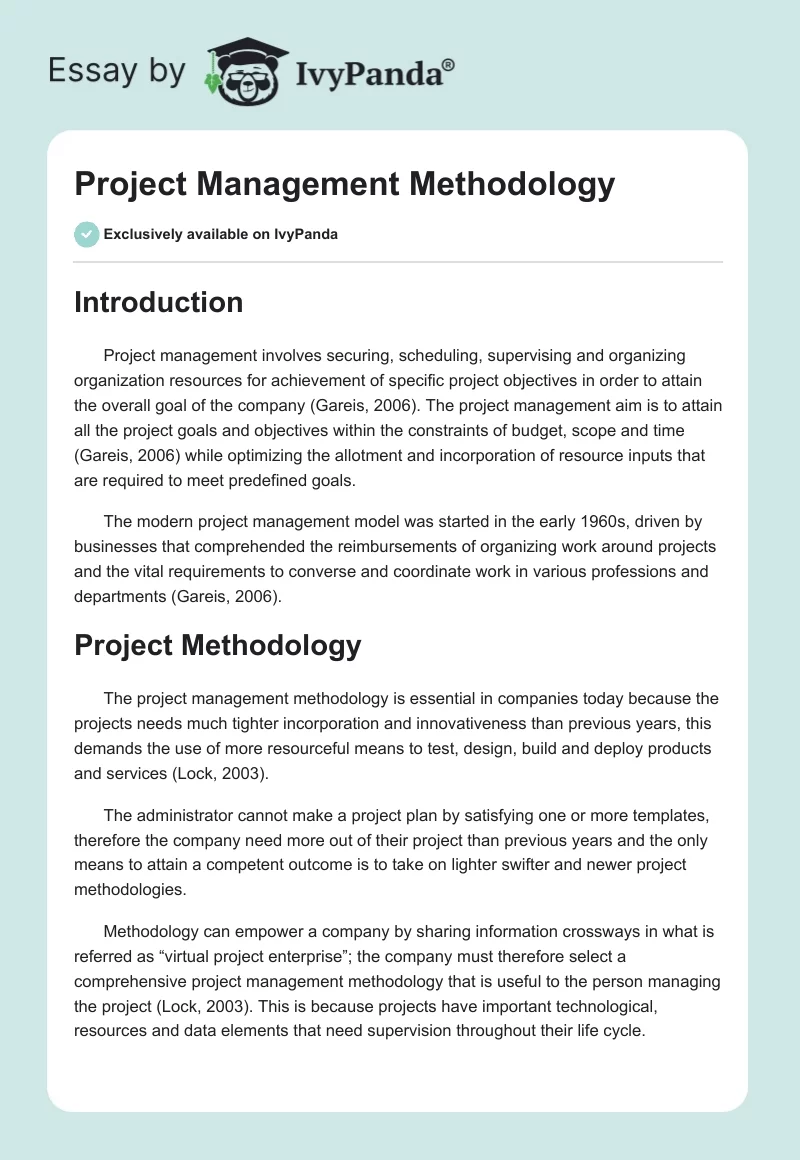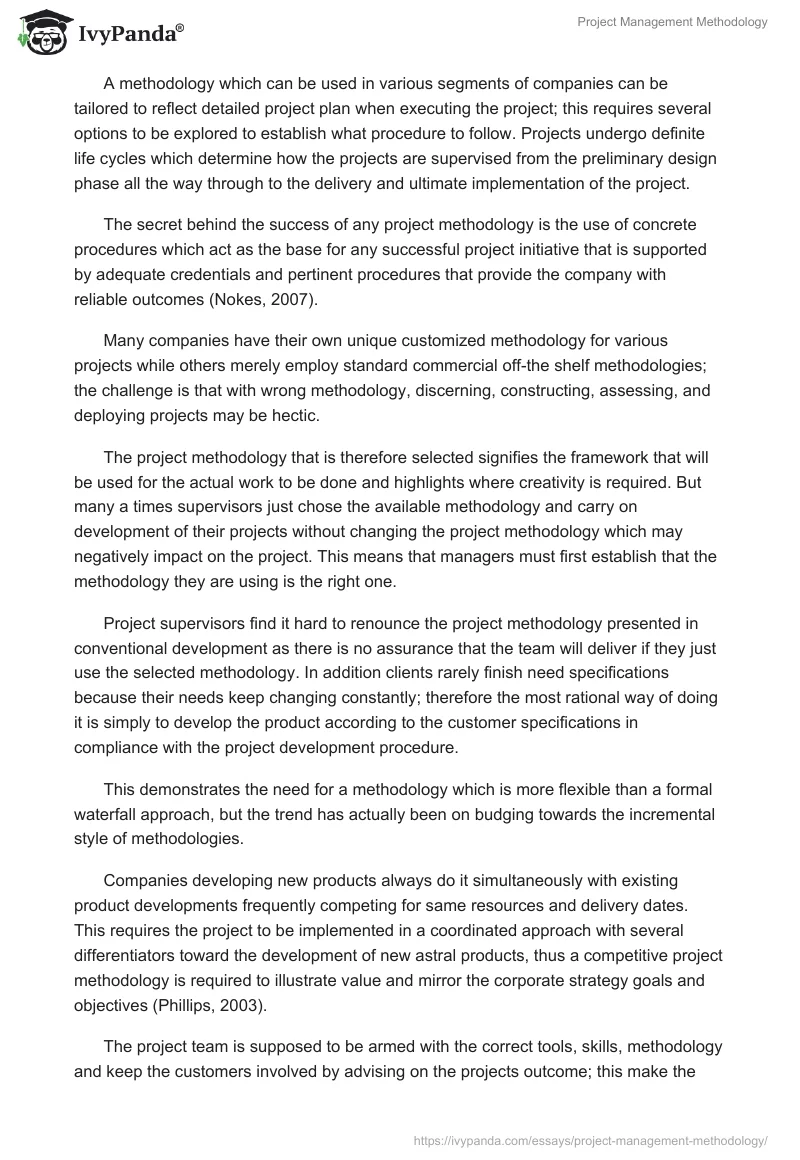Introduction
Project management involves securing, scheduling, supervising and organizing organization resources for achievement of specific project objectives in order to attain the overall goal of the company (Gareis, 2006). The project management aim is to attain all the project goals and objectives within the constraints of budget, scope and time (Gareis, 2006) while optimizing the allotment and incorporation of resource inputs that are required to meet predefined goals.
The modern project management model was started in the early 1960s, driven by businesses that comprehended the reimbursements of organizing work around projects and the vital requirements to converse and coordinate work in various professions and departments (Gareis, 2006).
Project Methodology
The project management methodology is essential in companies today because the projects needs much tighter incorporation and innovativeness than previous years, this demands the use of more resourceful means to test, design, build and deploy products and services (Lock, 2003).
The administrator cannot make a project plan by satisfying one or more templates, therefore the company need more out of their project than previous years and the only means to attain a competent outcome is to take on lighter swifter and newer project methodologies.
Methodology can empower a company by sharing information crossways in what is referred as “virtual project enterprise”; the company must therefore select a comprehensive project management methodology that is useful to the person managing the project (Lock, 2003). This is because projects have important technological, resources and data elements that need supervision throughout their life cycle.
A methodology which can be used in various segments of companies can be tailored to reflect detailed project plan when executing the project; this requires several options to be explored to establish what procedure to follow. Projects undergo definite life cycles which determine how the projects are supervised from the preliminary design phase all the way through to the delivery and ultimate implementation of the project.
The secret behind the success of any project methodology is the use of concrete procedures which act as the base for any successful project initiative that is supported by adequate credentials and pertinent procedures that provide the company with reliable outcomes (Nokes, 2007).
Many companies have their own unique customized methodology for various projects while others merely employ standard commercial off-the shelf methodologies; the challenge is that with wrong methodology, discerning, constructing, assessing, and deploying projects may be hectic.
The project methodology that is therefore selected signifies the framework that will be used for the actual work to be done and highlights where creativity is required. But many a times supervisors just chose the available methodology and carry on development of their projects without changing the project methodology which may negatively impact on the project. This means that managers must first establish that the methodology they are using is the right one.
Project supervisors find it hard to renounce the project methodology presented in conventional development as there is no assurance that the team will deliver if they just use the selected methodology. In addition clients rarely finish need specifications because their needs keep changing constantly; therefore the most rational way of doing it is simply to develop the product according to the customer specifications in compliance with the project development procedure.
This demonstrates the need for a methodology which is more flexible than a formal waterfall approach, but the trend has actually been on budging towards the incremental style of methodologies.
Companies developing new products always do it simultaneously with existing product developments frequently competing for same resources and delivery dates. This requires the project to be implemented in a coordinated approach with several differentiators toward the development of new astral products, thus a competitive project methodology is required to illustrate value and mirror the corporate strategy goals and objectives (Phillips, 2003).
The project team is supposed to be armed with the correct tools, skills, methodology and keep the customers involved by advising on the projects outcome; this make the project methodology adjustable to fit the solutions. The use of light or heavy methodologies in a company determines the success of the project.
According to Fowler (2001) escalating technological complexities, changes in customer needs and project delays bring in a little revolution in the world of methodology development. The introduction of new methodology such as agile and adaptive was opposed by heavyweight methodologies (Fowler, 2001).
This is because lightweight projects consist of few policies, preparations, documents and uses casual communication as it is designed and constructed through face-to-face discussions in meetings with customers (Fowler, 2001). On the other hand the heavyweight methodology uses SDLC approach which is bureaucratic in nature and has made many projects to be unsuccessful because of difficulties in swiftness of design, expansion and deployment challenges which slows down project completion.
In heavyweight a manager must get a complete list of user needs from the customer, failure to have the list, makes the methodologies not to work efficiently because the project will be racked with redraft, change, and slippages on the project documentation (Ireland, 2006). It works on the assumption that the more regulations and coordination the project has the better it outcome (Ireland, 2006).
Conclusions
These methodologies are useful especially when the company consist of multiple teams, working in various sites where there is need for close management and formalization of the project. In conclusion, the adoption of project management methodology depends on the company’s strategy and size, in this scenario the company size and strategy is not known and therefore no methodology can be prescribed.
However, depending on the company size and strategy the company can adopt the lightweight or heavyweight project methodology and the success of the methodology will rely on the use of solid reliable procedures that act as the basis of good estimation and implementation strategies when implementing projects.
References
Fowler. M. 2001. The new methodology: Thought work New York. Web.
Gareis. R. 2006. Global project management handbook. New York; McGraw.
Ireland. L. 2006. “Project management”. Boston: McGraw-Hill.
Lock. D. 2003. Project management. London: Gower.
Nokes. S. 2007. The definitive guide to project management. London: Prentice Hall.
Phillips. J. 2003. PMP Project Management Professional study guide, Los angles: McGraw-Hill.


